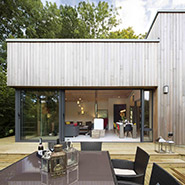Laying an engineered floor
Installation Instructions
Engineered Multiplank floors T&G
Important: proceed with a visual inspection of the strips before installation. Once installed, the strips are considered accepted by the installer and the owner.
Please read the entire installation instructions before proceeding with the installation.
Owner / fitter responsibility
Hardwood flooring is a beautiful and unique product of nature, which is characterized by distinctive variations in grain and colour. These natural variations in colour and grain are not flaws, but are a part of the natural beauty and uniqueness of hardwood flooring. These inherent variations should be expected and serve to enhance the natural beauty and enduring charm. Heywood floors are manufactured in accordance with accepted industry standards, which permit a defect tolerance not to exceed 5%. The defects may be of a manufacturing or natural type.
■ The installer assumes all responsibility for final inspection of product quality. This inspection of the whole flooring should be done before installation. Carefully examine the flooring for colour, finish and quality before installing it. Use reasonable selectivity and hold out or cut off pieces with glaring defects whatever the cause. If the flooring is not acceptable, contact your dealer immediately.
■ Before beginning installation of any hardwood flooring product, the installer must determine that the environment of the job site and the condition and type of the subfloor involved are acceptable, ensuring that it meets or exceeds all requirements which are stipulated in the Heywood installation instructions which follow. Heywood declines any responsibility for job failure resulting from or associated with inappropriate or improperly prepared subfloor or job site environment deficiencies.
■ Prior to installation, the installer/owner has final inspection responsibility as to grade, manufacture and factory finish. The installer must use reasonable selectivity and hold out or cut off pieces with deficiencies.
■ The use of stain, filler or putty stick for the correction of defects during installation should be accepted as normal procedure.
■ Should an individual piece be doubtful as to grade, manufacture or factory finish, the installer should not use the piece.
■ When Heywood hardwood flooring is ordered, a 5% allowance factor, depending on layout, must be added to the actual square meter amount needed. (Diagonal installations and/or board width of 200mm and over may require up to a 10% allowance factor.)
■ Please note that engineered wooden floors must be installed in environments of 40% to 65% relative humidity to prevent possible damage not covered by warranty. Installation of a humidifier or dehumidifier may be necessary. The floor is designed to perform in an environmentally controlled structure. Warranty exclusions are, but not limited to, surface checking resulting from low humidity, mildew or discoloration resulting from extreme sub-floor moisture.
Job site inspection and acclimation
■ This type of flooring can be installed below, equal or above ground level. Do not install in a bathroom.
■ In a new construction, hardwood flooring should be one of the last items installed. All work involving water or
moisture (plumbing, acoustical ceilings, dry wall taping, etc.) should be completed prior to wood flooring being
installed. Heating and air systems should be fully operating maintaining a consistent room temperature at 16°C to
27°C (60-80° F) and a constant relative humidity of 40% to 65%.
■ Flooring should not be delivered until the building has been closed in and cement work, plastering, painting and other materials are completely dry. Concrete and plaster should be cured and at least 60 days old. Check basements and underfloor crawl space to be sure that they are dry and well ventilated to avoid damage caused by moisture.
■ Handle with care. Do not stand on ends. Store Heywood flooring in a dry place being sure to provide at least a 10cm air space under and around cartons.
■ Do not store directly on concrete or near outside walls. Cartons should be placed in the installation area.
■ Flooring should be at the job site at least 72 hours for flooring up to 190mm width (7 days for flooring up to 300mm) or as long as necessary to meet minimum installation requirements for moisture content.
■ The humidity level of the house must be maintained between 40% and 65% all year long. Wood is a living product which reacts to humidity level variations. During summer, where the humidity level is at its highest point, the wood has a natural expansion and absorbs the humidity, these variations must be dealt with adequate dehumidification. As for winter, when the heating system is working, the humidity level is lower. It is then recommended to use a humidifier to minimise the extreme effects of shrinkage.
Installation methods (Floating, stapled and glued down)
and approved subfloors
Type of subfloor Floating Stapled Glued
Plywood 5/8” –OSB 23/32” (truss/joist of 16” c/c or less) YES YES YES
Plywood 3/4” T&G –OSB 23/32” (truss/joist of 19,2” c/c or less) YES YES YES
Concrete YES NA YES
Ceramic tiled floor, terrazzo, slate and marble YES NA YES
(Concrete) Radiant Subfloor heating YES NA YES
Radiant heating (plywood) YES YES YES
Subfloor conditions
■ CLEAN – Scraped or sanded, swept, free of wax, grease, paint, oil and other debris.
■ HORIZONTAL / FLAT – Maximum tolerance of 5mm over 3 meter, or 3mm over 2 meter.
■ Sand high areas or joints. If the floor is glued, fill the low areas with a latex additive cement surfacing product with a minimum resistance to compression of 20 000 kPa.
■ Concrete Slabs (regardless of existing floor covering): Use an approved calibrated concrete Moisture Meter as a preliminary measurement for moisture. Concrete subfloors must be finished at least 30 days before performing a test. Acceptable verification methods: Perform a polyfilm test. Tape down 60cm x 60cm polyfilm squares (a clear garbage bag or plastic drop cloth will do) in several places on the floor. Wait 24-48 hours, and then check for the appearance of condensation on the inside of the bag or plastic for a darkening on the concrete subfloor. Either occurrence signals the likely presence of excess moisture, which needs other measures with the concrete moisture meter Tramex. The measure must not climb over 4,5 on the superior graduation. The floor can be glued directly on concrete with a compression resistance of at least 20 000 kPa (3 000 lb/in2).
■ Wood Substrates: Test the moisture of the wood substrate using a calibrated moisture meter approved for testing wood moisture according to the meter manufacturer. The reading should not exceed 12%, or read more than a 4% difference than moisture content of products being installed.
Radiant Subfloor heating
NOTE: Always make sure that the selected product is recommended for this type of installation. Some species are not compatible and can not be installed on this type of subfloor; Jatoba, American Maple, Kempas, Ironwood, Ipé, Asian Mahogany, etc are some species that are not suitable for Radiant heating. Please ensure that the species you have chosen is suitable.
■ The heating system must be functional and working for at least 7 days prior to the floor installation.
■ Stop the heating and let the floor cool down to ambient temperature for 3 or 4 hours before starting the floor
installation.
■ Immediately start the radiant heating system after the installation, but take special care that you don’t raise the
temperature at floor level with more than maximum 5°C per day. The temperature of the finished surface cannot go over 27°C (80 °F) at all times for the duration of the flooring’s life span.
■ Radiant heating systems usually procure a dry heat which can lower the ambient humidity level. It could be necessary to use a humidifier to maintain a recommended level of 40% to 65% and prevent any damage to the floor.
■ Flooring installed on a radiant heating system must be glued at each end, in order to reduce the shrinkage in length. Apply a layer of recommended wood glue on the grooved side before inserting the strip.
Step by step installation instruction
(Glued down application)
STEP 1 – Establish a starting line
■ For best visual effect, it is recommended that flooring be installed parallel to the longest wall in the room.
■ Using a chalk line the area between the wall and the chalk line becomes your working area for starting installation, and your last installation area for completing the installation.
STEP 2 – Spread the adhesive
■ Apply the recommended adhesive with a trowel according to the manufacturer installation instructions (found on the adhesive pail) for the specific adhesive that is being used.
STEP 3 – Install the strips
■ Always select your strips with care. The more deeply coloured strips should be installed where they are less visible. Pieces with flaws should be re-cut.
■ Using the working area to install your flooring, line up the first strip with the tongue facing the wall, then press the strip into the adhesive and against the holding block.
■ Leave 6mm between the wall and the end of each strip in each row.
■ Start the second row with a strip of at least 15cm shorter or longer than the strip used in the first row. This will avoid aligning or clustering the end joints.
■ Continue with the subsequent rows in the same manner.
■ To avoid shifting or gaping of the strips during installation, use 3M blue tape to hold them together. Remove the tape within 24 hours. Avoid use of masking tape, which leaves an adhesive residue and may damage the finish.
■ When you get to the final row you will likely find it necessary to rip-saw the strips to fit against the wall. Install using the pry bar and leave 6mm minimum expansion spaces.
STEP 4 – Once installation is finished
■ Always keep a few spare strips from your initial installation for possible repairs in a sealed carton and properly stored.
■ Wait 24 hours before moving furniture and appliances back into the area where flooring was installed.
Power Tools
■ Table Saw, Electric Mitre Saw, Band Saw, Chop Saw, Power Jamb Saw, or Jig Saw.
Hand Tools
■ Broom and dust pan or Vacuum
■ Tape Measure
■ Moisture meter (wood, concrete or both)
■ Chalk line & chalk
■ 3M Blue Tape
■ Hand saw
■ Hammer
■ Rubber mallet
■ Tapping block
■ Pry bar
■ Filler stick and Touch-up marker
■ Hardwood Floor Cleaner
Additional Tools for Glue-Down
■ Recommended Adhesive & Adhesive Remover
■ Trowel (Follow adhesive manufacturer’s instruction)
Additional Tools for Staple-Down Installation
■ Pneumatic Stapler/Nailer
■ Staples/Flooring Cleats
■ Drill
Additional Tools for Floating Installation
■ 6 mil Polyethylene Vapour Barrier
■ Foam Underlayment
■ Floating Floor Glue
Step by step installation instruction
(Nailed/stapled down application)
Set-up and Use of Pneumatic Staplers and Nailers
■ Read and follow the manufacturer’s instructions for complete set-up and operation of equipment.
■ Make sure the adapter size for the pneumatic stapler or nailer matches the thickness of the flooring being installed and that the tool’s adapter seats properly in the tongue of the flooring.
■ Pneumatic nailer: Air pressure should be adjusted adequately for each species of hardwood floor installed and checked regularly (always try it before using).
STEP 1 – Establish a starting line
■ Using a chalk line, draw a guideline.
■ It is very important to start straight and square.
STEP 2 – Install the floor
■ Always select your strips with care. The more deeply coloured strips should be installed where they are less visible (i.e. in a closet or under the refrigerator). Pieces with flaws should be re-cut.
■ Use the longest, straightest strips available for the first row.
■ Install the first row of flooring with groove facing starter wall.
■ The first few rows must be nailed down by hand rather than with the nailing machine because of the vertical wall obstruction. Nailing interval should be at 15cm. Leave 6mm between the wall and the end of each strip in each row.
■ Start the second row with a strip of a least 15cm shorter or longer than the strip used in the first row. This will avoid aligning or clustering the end joints.
■ When the area is free from wall obstruction, you can repeat the installation using a pneumatic stapler.
■ It is also likely that you may have to ripsaw the strips to fit the final row against the wall. Leave 6mm minimum
expansion spaces.
Step by step installation instruction
(Floating application)
Important notice regarding expansion space: It is important to include an expansion space of 1.5cm between rooms (ex: hallway adjacent to a bedroom). You will need to fill this space with a moulding. Same rule applies for rooms exceeding 9 meter, you will also need an expansion space and a moulding.
STEP 1 – Install underlay
Install 6 mil Polyethylene vapour barrier over entire flooring surface. Overlap sheets of Polyethylene 40cm and tape together creating airtight seal. Run the vapour barrier 3 to 4cm up the walls and secure in place with tape.
Using underlay, roll out one roll at a time over the vapour barrier. There are many types of underlay available today. The use of acoustical underlay will improve the feel and sound transmission of your flooring.
STEP 2 – Preparing the starter rows
It is very important that enough expansion gaps are kept between the flooring and all the walls. This is done by placing 6mm spacers every 20cm apart around all vertical walls.
Measure the width of the room – perpendicular to the direction you intend to install the flooring. The last row of flooring should be no less than 4cm wide. If it is less, you should rip-saw the starter row narrower. Leave 6mm between the wall and the end of each strip in each row.
Start the second row with a strip of at least 15cm shorter or longer than the strip used in the first row. This will avoid aligning or clustering the end joints.
STEP 3 – Gluing the floor
In a floating floor installation, the flooring is not glued or nailed to the underlayment, but is glued in the board’s side and end grooves only. This is achieved by applying a bead of glue on the upper side of the groove along the entire length and on the end of each plank with T & G glue. Turn the board upside down when applying the adhesive to achieve proper application, when the board is turned again for installation with the finish side up, this will allow the adhesive to flow down and give better coverage. Do not apply adhesive on the top of the tongue.
Install the first row of flooring with groove facing starter wall. Use a tapping block and a mallet to gently push or tap the glued strips together until no gaps are seen and making sure that end joints are square.
At the end wall use a pry bar, if needed, to pull the ends of the boards tight. Continue laying the floor on top of the
underlay, working left to right, tapping the strips tight together. Make sure to continue using 6mm spacers along the wall throughout the installation.
To avoid shifting or gapping of the flooring during installation, lay perpendicular strips of 3M blue tape to hold the strips together. Remove the tape within 24 hours. Avoid use of masking tape, which leaves an adhesive residue and may cause damage to the finish.
The last row will most likely require cutting to width but it should be no less than 4cm wide. To do this, place a full row of strips on top of the last row installed. Insert a 6mm spacer against the wall, and using a full width strip, trace distance from wall onto final row. Cut strips for final row to designated width. Apply glue and pull into place with a pry bar.
Allow floor to dry for a minimum of 12 hours before removing all the spacers and allowing foot traffic.
Finally, install the transition pieces, baseboards and/or, quarter round mouldings.
Completing the job – all installation
Clean the floor with Hardwood Floor Cleaner. Please ensure that any adhesive on the finish is cleaned before leaving. Dried or cured adhesive cannot be removed.
Install transition pieces.
Inspect final floor for nicks or minor gaps and fill with appropriate colour wood putty.
Use plywood or hardboard when moving heavy appliances or furniture across floor.
“INSTALLATION IMPLIES ACCEPTANCE.”
NO WARRANTY WILL BE OFFERED FOR APPEARANCE RELATED CLAIMS ONCE THE PRODUCTS ARE INSTALLED.




